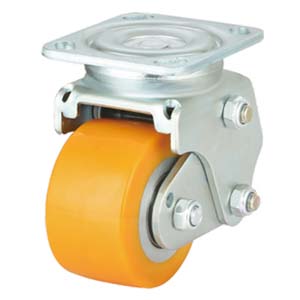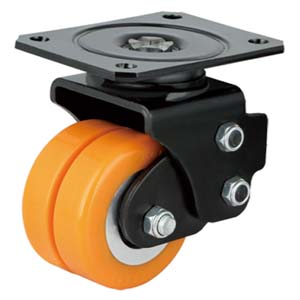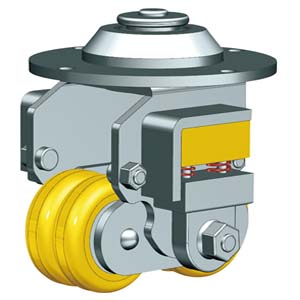- Best Price! Direct China Factory!
- Send Inquiry
WhatsApp/WeChat: 0086-137-36454395
AGVs or automated guided vehicles are vehicles that do not have an operator on board. They are operated from a remote location with the help of a controller. AGVs have helped to revolutionize many industries by making operations easier since they can carry heavy loads from one place to the other with the help of sensors and automation instead of a dedicated driver on board. But the AGV casters used in the AGV are every bit as important as the sensors and the automated mechanics. Why do you ask that is? Well, it is because the casters, which are the small wheels on the base of the AGV, are what allow the AGV to move.
The caster industry has evolved significantly over the years, and we can now see a variety of casters in the market that were not available previously. Even now, new and improved casters are being specialized consistently to cater to the budding market. Of course, the casters we use in AGVs are also specialized since any run-of-the-mill caster might not be the right fit and wear down fairly quickly. Therefore, AGV casters are specialized to ensure that they allow the vehicle to function without any hindrances.
Let us now take a look at the specializations that are included in AGV wheels:
Specialization Of AGV Casters
AGV, the term, does not pertain to just one kind of vehicle. There are a variety of AGVs used in different industries, and they all perform different functions. For example, we have Forklift AGVs, Towing AGVs, carts, Heavy carriers, and more intelligent equipment such as Autonomous Robots, which can navigate obstacles and are equipped with higher intelligence than other types of AGVs. However, since all of these AGVs serve different purposes, they cannot possibly make use of the same types of casters each time.
Most AGV casters available in the market are broadly divided into two types;
● Drive AGV Wheels
● AGV Shock Absorbing Casters
Other than that, there are a variety of customized casters available as well that cater to specific functions.
Many of these AGV casters also have an iron or aluminum core which is surrounded by a polyurethane coating as well.
Why Are These Specialized Casters Used For AGVs?
Normally, a suspension caster can only carry a certain amount of load easily and it goes up to 800 kgs. This amount of weight is perfect for most industries where AGVs are used, such as for manufacturing lines, for carrying raw materials, and for picking and replenishing stock to and from different locations. For these requirements, a caster that can carry anywhere from 600-800 kgs of maximum weight is ideal as well.
Suspension AGV casters also often have the option of swiveling. So the operator can easily make the AGV turn and change directions as per their needs while carrying the heavy loads. Therefore, suspension casters are often ideal for most types of AGVs and can help with the easy handling of material from one place to another.
As for shock absorption, depending on the terrain that the AGV is used on, the shock absorbing AGV wheels becomes a necessity. While AGVs equipped with some artificial intelligence can often navigate difficult terrain and find it easier to go from one place to another, most AGVs that are used in industries are not equipped with such intelligent features. So the remote operator needs to know the terrain in order to ensure that the cart goes from one place to the other smoothly.

While facility floors are not much of a problem in this regard, the AGV can come across some rough terrain when it is being used outside of the facility. A regular caster, when it traverses through the terrain, will not be able to protect the items loaded on the cart, and the rugged movement might also damage the goods that are on board.
However, a shock-absorbing caster solves this problem by absorbing any impact from difficult flooring and ensuring that the goods on board remain intact and unharmed throughout the journey.
Another reason why shock absorbing functions are important for AGVs is that the load that the AGV carries is often dropped onto the cart. This is usually the case because the mechanisms in the facility are usually facilitated through machinery which is human-operated, but humans do not come in contact with it directly. The impact that the dropped load makes on the cart will have an effect on the casters, and if the casters are not sturdy enough, they may give in on the spot.
Shock absorbing system absorb the drop impact of the load entirely and prevent the AGV or the load from being damaged because of that drop impact.
Furthermore, these types of specialized casters are important for an AGV mainly because there is no human operator onboard. Like in carts and other human-operated vehicles, the driver can often feel the impact that a certain load or terrain has on the cart, while without the operator, you need to take extra measures to ensure that the cart does not get stuck or damaged simply because no one was present to gauge the impact.
The iron and aluminum cores offer enough strength to be able to carry up to 800 kgs of material, while the polyurethane covering allows for the smooth movement of the vehicle.
Sometimes AGV wheels are also specialized to be able to operate in extreme temperatures or other harsh environments for which other alterations are also made to the wheels to suit the cart.
Conclusion
AGVs are crucial to many warehouses and other facilities where heavy items need to be carried using remote operators. Since AGVs have become so common, the key facilitator of their movement, the AGV caster wheels, has also been in the limelight. It is integral for manufacturers to specialize in AGV casters to make their movement optimal in any industry because that is the best way to ensure the safety and security of the material on board and that of the AGV itself as well. As time moves on, we will likely see even more advancements for AGV wheels as well.



 English
English Spanish
Spanish German
German Russian
Russian Arabic
Arabic Portuguese
Portuguese Italian
Italian French
French Hebrew
Hebrew Turkish
Turkish